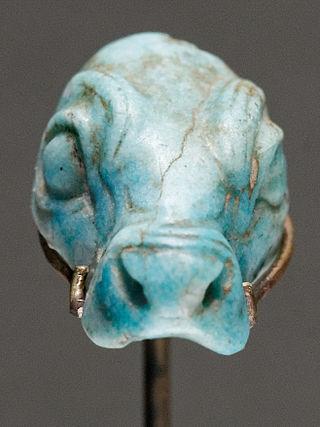
The Battle of Kadesh or Battle of Qadesh took place between the forces of the New Kingdom of Egypt under Ramesses II and the Hittite Empire under Muwatalli II at the city of Kadesh on the Orontes River, just upstream of Lake Homs near the modern Lebanon–Syria border.

Wilusa or Wilusiya was a Late Bronze Age city in western Anatolia known from references in fragmentary Hittite records. The city is notable for its identification with the archaeological site of Troy, and thus its potential connection to the legendary Trojan War.

Muwatalli II was a king of the New Kingdom of the Hittite empire c. 1295–1282 and 1295–1272 BC in the short chronology.
Tudhaliya I was a king of the Hittite Empire in c. the early 14th century BC.

Suppiluliuma II, the son of Tudḫaliya IV, was the last known king of the New Kingdom of the Hittite Empire, ruling c. 1207–1178 BC, contemporary with Tukulti-Ninurta I of the Middle Assyrian Empire.
Mursili III, also known as Urhi-Teshub, was a king of the Hittites who assumed the throne of the Hittite empire at Tarhuntassa upon his father's death. He was a cousin of Tudhaliya IV and Queen Maathorneferure. He ruled ca. 1282–1275 BC or 1272–1265 BC.
Mursili II was a king of the Hittite Empire c. 1330–1295 BC or 1321–1295 BC.
Muwatalli or Mutawallis may refer to:
Telipinu was the last king of the Hittites Old Kingdom, living in 16th century BC, reigned c. 1525-1500 BC in middle chronology. At the beginning of his reign, the Hittite Empire had contracted to its core territories, having long since lost all of its conquests, made in the former era under Hattusili I and Mursili I – to Arzawa in the West, Mitanni in the East, the Kaskians in the North, and Kizzuwatna in the South.

Alaksandu, alternatively called Alakasandu or Alaksandus was a king of Wilusa who sealed a treaty with Hittite king Muwatalli II ca. 1280 BC. This treaty implies that Alaksandu had previously secured a treaty with Muwatalli's father, Mursili II, as well. His name appears to be of Ancient Greek origin.
Tarḫuntašša' was a Hittite Bronze Age city in south-central Anatolia mentioned in Hittite documents. Its location is unknown. In 2019, a previously little-researched site at Türkmen-Karahöyük, near Çumra on the Konya Plain, was investigated and put forward as the site of Tarḫuntassa by Michele Massa, James Osborne and Christoph Bachhuber. Previously proposed locations include Konya, Sirkeli Höyük in Cilicia, the Göksu valley, the vicinity of Kayseri, Kilise Tepe, and Kızıldağ.

Nerik was a Bronze Age settlement to the north of the Hittite capitals Hattusa and Sapinuwa, probably in the Pontic region. Since 2005–2009, the site of Nerik has been identified as Oymaağaç Höyük, on the eastern side of the Kızılırmak River, 7 km (4.3 mi) northwest of Vezirköprü.

Zalpuwa, also Zalpa, was a still-undiscovered Bronze Age city in Anatolia of around the 18th century BC. Its history is largely known from the Proclamation of Anitta, CTH 1. But the Zalpa mentioned in the Annals of Hattusili I, CTH 4, is now convincingly identified as Tilmen Höyük, in the Karasu River Valley south of the Taurus Mountains by Tubingen and Chicago Universities recent excavations.
Huzziya II was a king of the Hittites. He was killed by Muwatalli I, who seized the throne and was possibly the Gal Mesedi of the royal bodyguard.

The Nineteenth Dynasty of Egypt, also known as the Ramessid dynasty, is classified as the second Dynasty of the Ancient Egyptian New Kingdom period, lasting from 1292 BC to 1189 BC. The 19th Dynasty and the 20th Dynasty furthermore together constitute an era known as the Ramesside period. This Dynasty was founded by Vizier Ramesses I, whom Pharaoh Horemheb chose as his successor to the throne.
The gal mesedi was a Hittite military and administrative title literally meaning "chief of the royal bodyguards". He was in charge of the Mesedi, the personal bodyguard of the Hittite king. It is considered to be one of the most important and prestigious posts of the Hittite Kingdom.

Kadašman-Turgu, inscribed Ka-da-aš-ma-an Túr-gu and meaning he believes in Turgu, a Kassite deity, was the 24th king of the Kassite or 3rd dynasty of Babylon. He succeeded his father, Nazi-Maruttaš, continuing the tradition of proclaiming himself “king of the world” and went on to reign for eighteen years. He was a contemporary of the Hittite king Ḫattušili III, with whom he concluded a formal treaty of friendship and mutual assistance, and also Ramesses II with whom he consequently severed diplomatic relations.
Rabâ-ša-Marduk, “great are of Marduk”, was a prominent physician, or asû, from the city of Nippur who was posted to the Hittite court of Muwatalli II in Anatolia in the thirteenth century BC, apparently as part of a diplomatic mission of Kassite king Kadašman-Turgu.

Gurgum was a Neo-Hittite state in Anatolia, known from the 10th to the 7th century BC. Its name is given as Gurgum in Assyrian sources, while its native name seems to have been Kurkuma for the reason that the capital of Gurgum—Marqas in Assyrian sources —was named "the Kurkumaean city" in local Hieroglyphic Luwian inscriptions.